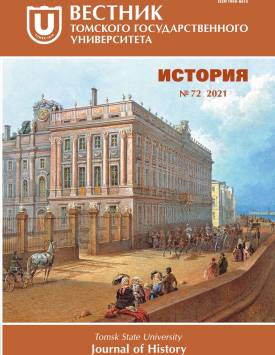Nikolay Muravyov-Amursky as the governor-general of Eastern Siberia and the regulation on the lamai clergy in 1853
The article is based on the materials of Russian State Historical Archive and Complete Collection of the Laws of the Russian Empire. The authors proceed from the hypothesis that the incorporation of Siberia into Russia led to the problem of relations between the state authorities and non-Russian peoples of the outskirt territories not only in agrarian policy and administrative structure, but also in the area of religious relations. The authors state that the confessional policy of the Russian government towards the Siberian "inorodtsy" was an inseparable part of the imperial policy in Siberia as a whole. In the church sphere of Asian Russia all of the autocratic activities were based on the recognition of the great political and socio-cultural significance of spreading Orthodoxy among " inorodtsy ". The embrace of Orthodoxy by the Aboriginal people was seen as an essential part of the integration policy. The authors conclude that the government's religious policy towards the Buryats was quite different in the Zabaykalsky region. According to the authors, the geopolitical specificity of the region and centuries-old Buddhist traditions forced the government to think not only in terms of religious but also in terms of foreign policy when forming the confessional politics in this region. With the increasing activity of Great Britain in the region, the "Lama issue" was becoming another pillar to promote Russia's interests in the Amur region. Buddhism began to spread through Eastern Siberia from the middle of the XVII century. In the year 1822, the Statute of Inorodtsy Management by Mikhail Speransky confirmed the right of the Siberian indigenous population to have religious freedom. However, the offensive movement of the Russian Orthodox Church against the peoples of Siberia, on the one hand, and the reduction of the profitability of the region, on the other hand, gave rise to doubts in certain circles of the Russian administration about the correctness of this policy. While working out the bases for solving the Buddhist question the Governor-General of Eastern Siberia Nikolay Muravyov-Amursky proceeded from the understanding of the danger of violent methods that could give rise to separatist sentiments. As a result, in 1853 the "Regulation on the Lamai clergy of Eastern Siberia" was adopted. The Regulation approved 285 staff Lamas and 34 datsan, all other Institutional roles were outlawed. In its fundamental features, this Regulation was valid until the end of the Romanov Empire. The authors conclude that the prohibitive features restri.
Keywords
indigenous populations, inorodsy, Lamaism, religion, Governor-General, management, outskirts, empire, Siberia, RussiaAuthors
| Name | Organization | |
| Dameshek Lev M. | Irkutsk State University | levdamshek@gmail.com |
| Dameshek Irina L. | Irkutsk State University | dameshek@rambler.ru |
References

Nikolay Muravyov-Amursky as the governor-general of Eastern Siberia and the regulation on the lamai clergy in 1853 | Tomsk State University Journal of History. 2021. № 72. DOI: 10.17223/19988613/72/4
